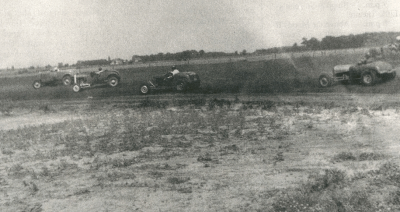
Window to the Past
Tales from the former Landeck Speedway
By BOB HOLDGREVE
The Landeck Race Track

The Landeck Speedway was in operation from 1949 to 1956.
Some of the local drivers included Amos Place, George Place, Tim Rode, Les Dancer, Don Foster, Jim Cooley, Walt Lear, Bud Claypool and Speed Rucker.George Place won more feature races than anyone else from 1949 to 1951.
In 1951, stock car races were introduced and no roadsters raced after 1952. C.S.R.A. ran some sprint races.
The following article written by Dale Fairfax is a colorfu1 account of the racetrack, the cars, and the drivers.
In mid 1948, two Van Wert county men embarked on what their neighbors surely considered the craziest stunt of the century.
Leo Bonifas and Mike Kill, whose properties adjoined at a country cross road about a mile west of Landeck, decided to destroy 40 acres of some of Ohio's finest cropland by converting them into a race track. A mile west of Landeck happened to be about 85 miles northeast of Muncie, Indiana, and it's reported that the decision to scrape a half mile oval out of that cornfield may have been influenced by the sound of Dick Frazier's Mercury or the smell of burning alcohol drifting that far on the prevailing summer breeze.
More likely, the scheme was born of Leo's love for auto racing. A confirmed fan, he had traveled to many tracks in the countryside straddling the Ohio-Indiana line to watch Big Cars and Roadsters. His neighbor, Mike, was no less avid a fan but had a measure of promoter's blood in his veins. Where Leo's desire was simply to provide a friendly, close-by home for local racers (of whom there were none at the time), Mike was less nobly motivated – he saw the dollar potential in promoting races.
Once the construction of the track was under way it was obvious that one ingredient was missing; race cars. There was no established club or association in the immediate area and those at some distance were either too well established (Mutual or one of the "Big Car" groups) to be interested in some upstart with no crowd or pay history or they had their hands full with existing "young" programs (Triangle and Ohio Roadsters). Mike Kill literally "went to town" to drum up some participation. One of his first stops was George Place's part-time general auto repair garage in the southwest corner of Delphos. (Delphos was the nearest "big town" at 6,000 population). George had never built a racer before but not long after Mike's visit he was a "volume" producer.
While Mike must have visited a few other mechanics, the stop at George's was probably the most fruitful. George laughs when he recalls those initial efforts: The cars weren't really "built"; rather they were cut down. Of the field of 9 cars at the track opener, George did 3. Two of these were literally torch jobs. One 132 Ford Coupe had its top removed, and large scallops cut out of the remainder of the doors which were then welded shut. Naturally the fenders were removed as was the hood but not the rear bumper. The car was raced with its stock tires, wheels and engine. A 132 Plymouth was similarly whacked but memory says it had a racier appearance; probably due to its 33 DeSoto grille. Later owned by local wheeler/dealer Cliff Hillin, it was driven by Jim Cooley. (Cliff Hillin was a local character given to fancy clothes, the "good" life, and a huge Chrysler Town & Country convertible with air horns. An appliance store owner in Delphos, he became Landeck's announcer.) George's personal car was considerably more artistic and as old photos show, had a relatively professional appearance. Long, low, smooth-lined with cowl, hood, and grille from a 135 Hudson and tail made from the deck of a 133 Plymouth Coupe; it was powered by a Hudson 8. The chassis was typically mostly Ford. It was the forerunner of a long line of Place built, Hudson powered cars.
Others who contributed to that first field included Gene Shaffer who built a car from a 135 Buick - straight 8 and all. It was very similar in appearance to George's #8 Hudson. Gene also built a Ford 6 powered car which had a "generic" Model T body. Mike Kill himself provided a car which from a distance had the lines of a "genuine" race car but was pure country in its origins. One might describe its construction as "aircraft" style as the body was built by wrapping sheet metal over ring bulk heads or formers. These rings were wagon wheel tires straight off the farm. The car was stout enough to run on the railroad but its poor stock 133 Ford V-8 just didn't provide much steam.
Mike's missionary work obviously paid off since it wasn't long before other area mechanics and latent racers came out of the woodwork and found each other at the Landeck Speedway. They had discovered a form of racing that didn't exclude them; one that didn't require deep pockets and far reaching influence. Almost anybody with a touch of mechanical savvy or a bit of nerve could join in and afford the dues. And, best of all, there was a track that wanted them. The situation wasn't terribly unlike that of 1939 which fostered the birth and growth of the Mutual Roadsters who were to become the guiding light to these neophyte racers.
(To be continued Aug. 17)
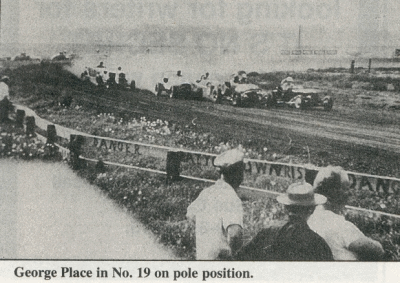
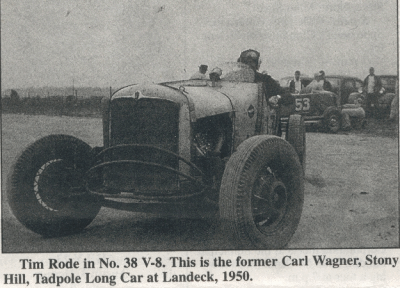
Compiled by Robert Holdgreve
Delphos Historical Society
July 20, 2002 Delphos Herald Newspaper
Tales from the former Landeck Speedway
(Continued from July 20)
Over the winter of 1948, most of those who had been caught up in this Kill-Bonifas scheme recognized the value and the need for cooperation and union. At a meeting in a garage in Spencerville, the Buckeye Roadster Association was conceived. Most of the membership was from Delphos and Spencerville (Landeck’s population was probably less than 50, most of which was the captive staff of the Catholic school. Not many racers there).
It would be fair to say that fame has eluded those young men. None of them ever advanced through the ranks to stardom as did their counterparts in California. The best they accomplished was to have their names appear in the columns of Speed Sport News or Illustrated Speedway News during the next two to five years and to have an opportunity to bang wheels with some who did become well known.
Some who later raced with them achieved a degree of fame but for the most part the notoriety was brief and local. Strangely, Mutual did not produce a significant number of stars at the national level. Given the attention garnered by its long running show in the Indiana/Ohio area and its high level of competition and mechanical sophistication, Mutual's members surprisingly did not graduate to Indy and AAA/USAC in significant numbers. (Pat O'Connor was an exception - not a rule.)
With the formal opening of a season of scheduled racing under the Buckeye sanction in 1949; some "real" race cars began to appear. Many of the Buckeye group had by now been exposed to the roadstering efforts of the Mutual and Ohio/Triangle Associations at places like DeGraff's Shady Bowl or Dayton and had a perception of a roadster that transcended the cut down stockers that filled the first fields. Those with the burning desire or the finances (or both) set out to catch up with those outsiders who had been at it longer. To the credit of a hard core minority within the group, they accomplished in two or three years what Mutual's runners had taken 10 or more to achieve. Admittedly, they didn't develop the technology; they adopted it. Mutual's cars and drivers were the primary models.
Certainly the most technologically advanced of the local efforts was the #66 Chevrolet fielded by the Hardesty Chevrola Agency. Admittedly the car bad a head start on all the others - at least from the standpoint of planning - it was conceived before Leo and Mike came up with their idea. Dick Hardesty was a typical "motor head", having grown up in the automotive environs of the family business and studying not only the literature of California's burgeoning speed/power industry but also the work of successful racers from places like Marion and Dayton. These were folks who had been running for several years at tracks like DeGraff, Jackson Carter, and Greenville, plus over in Indiana at New Castle and Montpelier. Combining Dick Hardesty's state of the art knowledge with the blessing of his father Jack and access to a fully equipped "race shop" meant that the Hardesty team hit the, ground running while everybody else found themselves at the bottom of a steep learning curve. Even the driver came from within the Hardesty shop. Don Jones was the body and paint man who built the chassis and body of the car. (Does anyone out there remember him and what ever became of him?) No. 66 displayed a level of construction quality and finesse that wouldn't be matched for months to come. The engine was refined with three carburetors on a special manifold from California. The camshaft was also a California piece while the cylinder head was I or by a longtime professional racecar builder from Marion. Few, if any, of the other locals had been that far into their engines in preparation for the inaugural season
Dick Andrews, a friend of George Place, had George build a chassis but bought a Mercury from Tom Cherry. George drove the car (after selling his original #8 Hudson to Bud Claypool) to the 1949 Buckeye Championship.
Frank Crane from Lima did the quick and dirty: he acquired a complete car from Mutual's Ermil McCormack (#62 Mercury driven by Everett Burton) and repainted it into the Lost Creek Garage #52. Jimmy Garmotta of Lima was the regular pilot.
George Place and later his brother Amos looked to Joe Walls for guidance in exploiting the performance potential of Hudson Sixes. George and Amos were to build and drive their own numbers 18 and 32.
George Bayman from St. Marys built a hot Chrysler 6 powered machine which was numbered 38 but was better known as the "Wild Goose". It was driven by Carl Rockwood.
As reported by The Journal News in early 1949, St. Mary's Gary Bupp driving the Schafer car was unbeatable in the first month of competition. Another that tried was Frank Gudakunst from Ottoville who installed a '41 Cadillac V-8 in what appears to be a M-5 tank that sat on the lawn of the Delphos Public Library for years. That engine replace the one rank removed from his '41 Cadillac to power the roadster.
The Suever brothers who owned a stone quarry near Landeck but more importantly a Nash agency in Lima, built a neat car in 1950 with (what else?) a Nash 6 (the flathead version). Driven by Jim Cooley of Delphos, it did well but was a bit down on power - later it did better with the O.H.V. Ambassador engine.
While the above only accounts for some half dozen examples of state of the art equipment developing during that formative period, it doesn't mean that Buckeye races were all one sided affairs. As in any circuit there were the dominant teams and yes, the aforementioned were that; but, on any given Sunday they had to contend with the visits of Paul Hooper from Marion, Ohio, with his 12 port Chevrolet; Bobby King from Muncie in a variety of Mutual V-8s; Ralph Stover in Joe Wall's #16 Hudson; Red Amick in his Mercury; Elzie Whitnall from Columbus, Ohio; Tex Shackleford in Joe Mattis' Mercury from Dayton;, and others whose names appeared regularly in Mutual lineups. Even with many of the locals continuing to do little more than maintain car count, the fact that the Landeck track and the Buckeye Association (the group sanctioned a few shows at Allentown) existed meant that local racers and fans (like the writer) had an opportunity to participate in and be entertained by some of the most exciting dirt track racing ever. Without having to drive 100 miles, one could be exposed to the best drivers and best cars of the era. The mystique of the visitors (amplified by the misinformation born of no information) could have been no greater had they come from California. The proud feeling that came from comparing the better efforts (both mechanical and competitive) of the local hot shots against the invaders was as good as when the home basketball team won.
The roadster era was brief; lasting only about four years. By 1953, most of the really good roadsters had "grown up" into sprint cars. The local Sunday shows gave way to occasional CSRA or AARA events at distant venues. Local racing became the domain of hardtops. For those who launched a racing career from these humble beginnings the memories of those four years are melded into the events of subsequent activities. To accurately recall the timing of events that occurred only months apart is or has been difficult. Thankfully, Dick Hardesty and George Place are still available and have good recollections of that time. They have provided most of this information while George’s photo collection has proven invaluable.
Anecdotes abound. George relates how he sold his original #8 Hudson to Bud Claypool. Bud wasn’t too well fixed and had difficulty paying for the car s a settlement was negotiated: George got the engine back – Bud kept the car. In the meantime, another car of the original Landeck 9, the Schaffer built Buick powered car, had been sold to the Kaskel Brothers who owned a Delphos garage. The car was demolished by either Gary Bupp or Bud but the engine was salvaged and found its way into the #8. The Buick put so much front end weight in the car that it never after wanted to turn. One of Bud's attempts at chassis tuning was to tie a bag of crushed stone to the left rear axle housing (crushed stone? Naturally; Bud worked at the stone quarry.) to give it some inside rear weight bias. While running, a hole wore in the bag, allowing the crushed limestone to spew out in a stream like a water leak. Its not reported whether or not the push was cured before the ballast leaked off; is this the origin of the term: "the handling went away?" (To Bud's credit, he later built some fine supers in the 60's and he did qualify for the little 500 at least twice in the early 50's.)
Dick Hardesty tells how an inebriated Paul Hooper just insisted on resetting the timing in the Hardesty #66 Chevrolet. Paul "could tell by the sound" that Hardesty didn't have enough spark lead in the potent 235 Chevy. Dick reluctantly conceded, not wanting to engage in a futile argument with the irrational Paul. He watched while Hooper moved the mag "about an inch" but thought "I can always reset it back to my mark." Dick got in the car, fired and set off around the Allentown track. He knew it wasn't right so he came in claiming that all that advance was causing it to heat up and thinking maybe Paul would just go away. Paul, not to be put off, agreed to set it back but he retarded it ever so slightly - not back to the mark. Dick took the car out again and to his amazement the change had lit a fire in it. He said his dad indicated that his speed would have put him on the pole but wouldn't tell him his time. Jack was afraid that his young chief mechanic would suddenly develop driving aspirations if he really knew how fast he could get around the track.
Again from George, the story of a local guy, Nelson "Nelly" Grothouse who built one of the very early cars. It was a Chevrolet with no floor and no belly pan. Every time Nelly stopped his feet dropped to the ground and it looked like he was dragging his feet in lieu of brakes.
The Buckeye Association was never more than an "asteroid" orbiting about the planets of other Ohio roadster groups and the Mutual sun. Its light was probably only visible to those within 25 miles of the track in the middle of nowhere (or to those visitors from afar that thought there might be some easy "pickins" out in the corn country.) Its life was brief but its existence opened the door to the racing universe for a great many folks. In this writer’s view it was simply the best of times.
Dale Fairfax
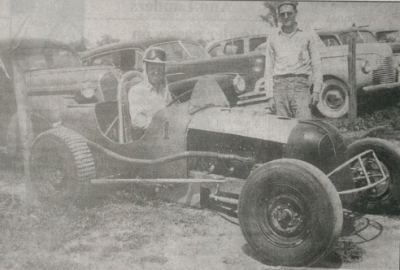
The beginning of the 1949 Buckeye Roadster Association
Championship. George Place driving Dick Andrews’ No 1 car.
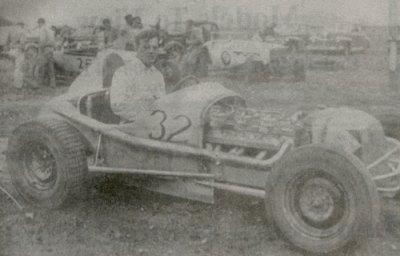
Amos Place in the No 32 car.
Compiled by Robert Holdgreve
Delphos Historical Society
August 17, 2002 Delphos Herald Newspaper